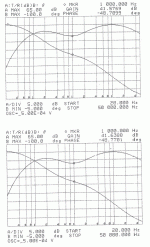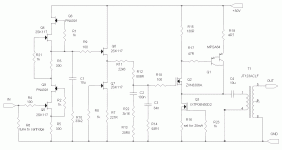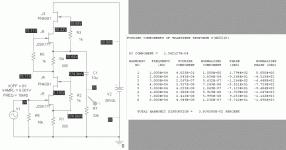This is a pic of the "lemon-lime" SRPP board. A schematic will follow when the thing is functioning to my satisfaction.
Nice. Did you give it a listen yet? Those USSR green caps are good.
Well, the second stages using the "2SK30As" I got off of fleabay are not working, though the device appears to be pinned out right as placed on the board. The two input stages (using PN4393) look ok, each delivering ~1/2 VCC output (a sign of good health in a jfet SRPP). I may just match up a set of PN4303s and replace the suspect jfets in the second stage, just so I can move along quickly.
Everything is working now, for the time bein using Vishay PN4393 in the first stage and Fairchild PN4303(I decided to live dangerously) in the second stage. Attached are the gain-phase plots for the two channels, showing good matching. Good sound? That remains to be seen. The gif file is a little large (99k) but hopefully not too taxing on folks.
Attachments
I've actually now built a version of the SRPP preamp using symmetric cascoding for all the SRPP stages, as shown in some simulations I did back in December 2010. I had a sneaking suspicion that a real implementation of this circuit would have probems with output voltage centering - I was right. Shorting out the cascode jfets on one of the stages restores proper output centering. I will obviously need to look into this further as time allows.
I also tried simulating an SRPP stage using the 2SK117 - lots of gain (too much for me), and also fairly mediocre THD. The THD is comparable to what I could get using a cascoded 2SK170 common source amp, so why bother with the extra complexity? I'll look at this some more as well as time permits, but that's my initial impression from my first simulation attempts.
I also tried simulating an SRPP stage using the 2SK117 - lots of gain (too much for me), and also fairly mediocre THD. The THD is comparable to what I could get using a cascoded 2SK170 common source amp, so why bother with the extra complexity? I'll look at this some more as well as time permits, but that's my initial impression from my first simulation attempts.
The cascoded SRPP preamp has been stalled for quite a while in favor of other projects, and waiting on some concerted effort from me to solve the balancing issue. I think the solution might lie in carefully matching the cascode fets as well as the gain fets, as the PN4393 does not have the flattest Id Vs Vds characteristic in the world.
At ay rate, I finally installed my "Lemons and Limes" 4393 SRPP in my system. A real wring-out will have to wait until I replace the needle on my Grado Gold cartridge and do a careful alignment and resonance -chasing job. Preliminary results are "thumbs up", though, even with the ganky setup I have right now.
At ay rate, I finally installed my "Lemons and Limes" 4393 SRPP in my system. A real wring-out will have to wait until I replace the needle on my Grado Gold cartridge and do a careful alignment and resonance -chasing job. Preliminary results are "thumbs up", though, even with the ganky setup I have right now.
I might give my 2SK30s another chance later on. Right now, the board as presently constructed will stay in the system for a while so that I can get a handle on its sonics. It's replacing my all-PN4391 board, which unexpectedly turned out to be a hiss factory. That looks to be at least in part due to a poor choice of current source for biasing the output stage (LM317L - nice on paper, a snake in real life). I may take my die-cst test box and rig it so that I can run preamps externally and plug them into one of my aux inputs, making quick in-and-out testing easier.
Here's a New Year's present to think about. Using a high-gain fet like the 2SK117 in an SRPP stage allows one to get most of the gain needed for a MM phono cartridge in one whack, in this case, about 300X. Distortion is not too shabby at max signal, being around 0.07%, mostly 2nd harmonic. It's correspondingly less at lower amplitude (who runs their system at full-clip levels, anyway?). Cascoding the SRPP in this case is imperative because of the high gain, so I'll have to solve the balancing problem I'm seeing in cascoded SRPP stages - it may just be a matter of closely matching the cascode fets as well as the gain fets. After a passive RIAA filter, a power buffer drives a step-up transformer for another 4X gain. This isn't something I'm going to hop on right away, but it does provide food for thought. Another approach might be to replace the buffer/transformer with the buffer-with-gain circuit shown in the "Liniac Revisited" thread.
Attachments
Last edited:
Here is the sim data for the 2SK117 cascode SRPP. The capacitively coupled SRPP load resistor sets the overall gain at 400X, which is a good match for the Jensen output transformer (3X) to arrive at 40dB gain at 1 kHz, suitable for the usual MM/MI setup. Those worried about overload, seeing that most of the gain is in the first stage, could use a higher rail voltage for more headroom. This is starting to look interesting - I may actually build this circuit when I get a few other projects out of the way. The IXYS depletion mode fet used in the current source for the output follower could probably be replaced with a Supertex DN2540N5 depletion mode fet, a part a little easier to source.
Attachments
The End
Richard,
You have been working in this thread from 2005. That is a long time. I like the flow of ideas, application and time. I like how you keep coming back at the JFET with a new twist. It need not be a snob value hard to find JFET. It is the three-legged bug, even a garden-variety bug is better, that you are after. I think that is very cool.
I am wondering about the application of the output transformer. The price is maybe 2 orders of magnitude greater than the JFETs. Is there a silicon way to due it without the expensive iron?
You could be the author that has not finished the last chapter of a mystery thriller.
Happy New Year
DT
Richard,
You have been working in this thread from 2005. That is a long time. I like the flow of ideas, application and time. I like how you keep coming back at the JFET with a new twist. It need not be a snob value hard to find JFET. It is the three-legged bug, even a garden-variety bug is better, that you are after. I think that is very cool.
I am wondering about the application of the output transformer. The price is maybe 2 orders of magnitude greater than the JFETs. Is there a silicon way to due it without the expensive iron?
You could be the author that has not finished the last chapter of a mystery thriller.
Happy New Year
DT
Use the output buffer with gain that I mentioned. It has very low distortion, and has been making nice sounds in my home system for close to a year. The costs are lower, but you give up the galvanic isolation of the transformer. Also, with the transformer you could do a balanced output if you felt like it.
I can see two cascoded jFETs (117) in the front end.
Yes, that's what I said as part of my questions.I think that there are 2 cascode fet cells J5,J4 & J6,J3.
- Home
- Source & Line
- Analogue Source
- JFET SRPP RIAA Preamp



